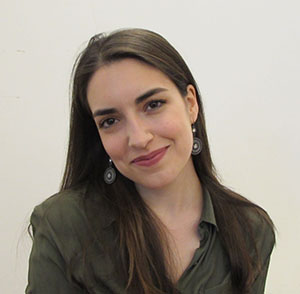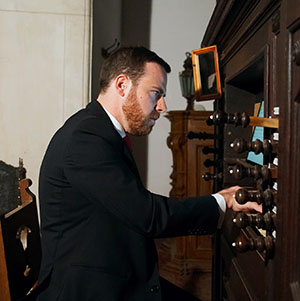 Tuesday, October 23, 9.30 pm
Tuesday, October 23, 9.30 pm
Church of São Pedro
Romanticism in England
Cecília Rodrigues, soprano
Sérgio Silva, organ
In England, the organs of the beginning of the 19th century, classical in aesthetic, were simple instruments, most of them with only one manual, no pedalboard, and with a rather limited array of sonic resources. It was this kind of instrument that was available to Samuel Wesley, a prolific composer for organ and of sacred music at the highpoint of the English classical period, from which there will be performed representative works from two of the most important of the composer’s collections – Twelve Voluntaries and Twelve Short Pieces for Organ.
With the advent of romanticism, one cannot avoid mentioning the greatly appreciated presence of Mendelssohn in England, in spite of the fact that he was a German composer of Jewish origin. Amongst his main sacred works, St Paul received its première in England in 1836, in Liverpool, Lauda Sion in 1848 and Elias was first performed in Birmingham in 1846.
The son of Samuel Wesley, Samuel Sebastian Wesley (Sebastian in homage to the great Bach) was an organist of great renown in England, obtaining positions in a number of English cathedrals. His output for organ is essentially made up of two sets of Three Pieces for a Chamber Organ, from which comes Choral Song and Fugue. The first movement, performed in this programme, is a kind of chorale prelude, with rather homophonic writing, with dense chords and melodies in octaves. Though organ building in England had now undergone a clear evolution in comparison with the classic models, Choral Song is entirely written for an organ with a single manual, whose ranges goes down to low G, a characteristic present in some organs on the island of Madeira.
Another composer representative of English romanticism is Arthur Sullivan, known chiefly in the field of opera, but whose activity extended to choral, orchestral and religious music. Awarded the Mendelssohn Scholarship by the Royal Academy of Music, he wrote the Festival Te Deum, a work commissioned to celebrate the recovery from typhoid fever of Albert Edward, Prince of Wales (later Edward VII, King of the United Kingdom), from which is excerpted When Thou tookest upon Thee, featuring solo soprano.
Edward Elgar, perhaps the most noteworthy English romantic composer, renowned the world over for his Pomp and Circumstance Military March no. 1, wrote a vast amount of music for choir and for organ. His collection Three Motets, written in 1887 for choir and organ, is a familiar part of the choral repertoire, performed today in a version for soprano and organ. Though the organ was not his favourite instrument, Elgar had a direct relationship with it, having replaced his father in 1885 as organist of the Catholic Church in Worcester. From his connection with the organ there arose two works of significance: the Sonata in G major, op. 28, written between 1895 and 1896, and Vesper Voluntaries, Op. 14, published in 1890, whose title aims to continue the English organ tradition. The Light of Life, originally Lux Christi, was Elgar’s first oratorio, recounting the episode of the blind beggar and Christ’s restoration of his sight, from the Gospel of St John.
Sérgio Silva
Samuel Wesley (1766-1837)
¬ Voluntary I, Op. 6 (1812) *
Felix Mendelssohn-Bartholdy (1809-1847)
¬ Jerusalem, thou that killest the Prophets
(Paulus, Op. 36, 1836)
Samuel Wesley
¬ Air and Gavotte *
(Twelve Short Pieces for Organ or Harpsichord, 1817)
Felix Mendelssohn-Bartholdy
¬ Hear ye, Israel
(Elias, Op. 70. 1846)
Samuel Sebastian Wesley
(1810-1876)
¬ Adagio *
Felix Mendelssohn-Bartholdy
¬ Caro cibus
(Lauda Sion, Op. 73, 1846)
Samuel Sebastian Wesley
¬ Choral Song *
(Three Pieces for a Chamber Organ I, 1842)
Arthur Sullivan (1842-1900)
¬ When Thou tookest upon Thee
(Festival Te Deum, 1872)
Edward Elgar (1857-1934)
¬ Introduction and Andante *
(Vesper Voluntaries, Op. 14, 1890)
¬ Ave verum corpus
(3 Motets, Op. 2, 1887)
¬ Allegro *
(Vesper Voluntaries, Op. 14)
¬ Ave Maria
(3 Motets, Op. 2)
¬ Allegretto pensoso *
(Vesper Voluntaries, Op. 14)
¬ Ave maris stella
(3 Motets, Op. 2)
¬ Poco allegro *
(Vesper Voluntaries, Op. 14)
¬ Be not extreme, o Lord
(The Light of Life, Op. 29, 1896)
* solo organ
Participants
|
Cecília Rodrigues began studying the piano at the IGL, and later vocal technique with Elsa Cortez at the same school. At the age of 18 she went to the EMCN, where she studied singing with Manuela de Sá. She continued her studies at the Higher School of Music in Lisbon, where she is currently completing a masters in music education with Luís Madureira. She has worked with Lucia Mazzaria, Milagros Poblador, João Paulo Santos and David Santos, and she works regularly with the baritone Luís Rodrigues. She has won the 2013 Prize for the performance of Portuguese music in the City of Fundão International Competition; the First Prize and Prize for the performance of Portuguese music in the City of Almada International Competition 2015; and the First Prize in Singing in the Youg Musicians’ Prize, Radio 2 – RTP. She appeared as a soloist in the “Sons da Água” festival in 2016 and 2017, under the direction of António Costa. She collaborated with the Olisipo Vocal Group in a concert dedicated to Monteverdi at the Belém Cultural Centre, and gave a recital with João Paulo Santos in the Serões Musicais festival at the Pena Palace in Sintra, later recorded for Radio 2. She sang Bess, from Porgy and Bess by Gershwin, in the Música no Colégio festival 2018, with the Coral São José, Ponta Delgada. She was a member of the Choir of the Casa da Música and is a member of the Gulbenkian Choir, with which he has performed as a soloist in a concert of music by Gershwin, and in Bach’s St Matthew Passion. |
|
Holding a masters degree from the University of Évora, Sérgio Silva began studying organ at the Gregorian Institute of Lisbon under João Vaz, and accompaniment and improvisation under António Esteireiro. In addition, he had the opportunity to work with a number of organists of international renown, such as José Luis González Uriol, Luigi Ferdinando Tagliavini, Jan Willem Jansen, Michel Bouvard, Kristian Olesen and Hans-Ola Ericsson. As a concert performer, he appears regularly both as a soloist and a member in a number of prestigious Portuguese ensembles, and has performed in Portugal, Spain, Italy. Great Britain, France, Germany and Macau. As a researcher, he has made a number of transcriptions of early Portuguese music. He currently teaches organ at the Gregorian Institute of Lisbon and at the Lisbon School of Sacred Music, and is titular organist of the Basilica of Estrela and of the Church of St Nicholas in Lisbon. |
Notes about the organ
 Church of São Pedro, Funchal
Church of São Pedro, Funchal
The organ of the church of São Pedro was obtained in England from the firm Flight & Robson in the 19th century. We have no documentation relating to its construction but we may place it as before 1878, when the firm was bought by Gray & Davison. We know equally little of the exact date of the installation of the instrument in the church, but in two inventories (1838, 1841) there is reference to an organ “of which much use is made” placed in the choir gallery, which point to the present instrument (AHDF Inventário: 3). In the course of the 20th century, the organ underwent various repairs, as a result of which, among other things, the pitch and tuning were altered, without, however, causing any significant damage to the original state of the instrument.
In August 1904, in the course of a campaign to make improvements to the choir gallery of the church, the Benefice took advantage of the opportunity to have the organ repaired, the restoration being undertaken by Alfredo Saturnino Lino. We know that the work to the organ, as to all the rest, took a short time, for in a note signed 6 August 1904, the builder stated that the work "should be finished by the middle of the present month". The works actually finished on 25 August; all told, the work to the choir gallery and organ cost 150,000 réis, to which the District General Council contributed the sum of 50,000 réis, given over entirely to the repairs to the organ. Apparently, this work was a one-off intervention, for only two years later, the newspaper Heraldo da Madeira, on 15 November 1906, reported that the organ of the church of São Pedro was once more under repair. In 2006 a full restoration was undertaken by Dinarte Machado.
Manual (GG, AA, C, D-f’’’)
Diapason 8’
Principal 8’ (c-f’’’)
Principal 4’
Flauta 4’
Piphar 2’
Cornet
 Cecília Rodrigues
Cecília Rodrigues Sérgio Silva
Sérgio Silva